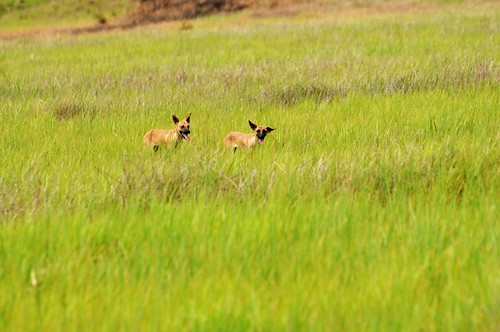
My first thought when we got any kind of elevation to take a look over the landscape was how much it resembled a steppe or an african plain. The thatched hut look of the settlement at Kavak (below) only confirmed the impression. Sadly there were no big herbivores in sight. South Africa (like North America) used to have an array of big grassland herbivores, glyptodonts, ground sloths and so forth, as well as the carnivores that inevitably followed. Some big animals remain (giant anteater, puma, jaguar, whitetailed deer) but the majority were hunted to extinction.

I was a little bit surprised therefore as we wandered across the plains when the pair below loped out to meet us. I couldn't really work out what they were at first. I dared to think of maned wolf at first but what they really reminded me of was the Dhole. Dhole (aka Asiatic Wild Dog, Indian Wild Dog or Red Dog or Cuon alpinus)are now restricted to small parts of asia but used to roam across the northern hemisphere in Europe and North America - I don't know how far south they made it before being extinguished in the Americas.

If anyone noted a resemblance to North America's wild Carolina Dogs then, logic prevailed, these are, of course, domestic dogs and their owners soon appeared in view too. Nonetheless, domestic or not, for a second they rewilded the landscape in style - they still fit right in. Harking back to pleistocene rewilding once again, because I am just finishing William Stolzenberg's wonderful "where the wild things were", true Dhole are available for reintroduction into North America although interbreeding and competition with domestic dogs would need to be avoided as much as possible. Domestic dogs are in a different genus to Dhole by the way which they share with coyotes and wolves although some researchers have argued that in fact Dholes were the species from which dogs were bred. Beyond noting that I have nothing to add as dog evolution is a difficult area which is beyond me.
2 comments:
Just gorgeous!!!
Thanks Keetha!
Post a Comment